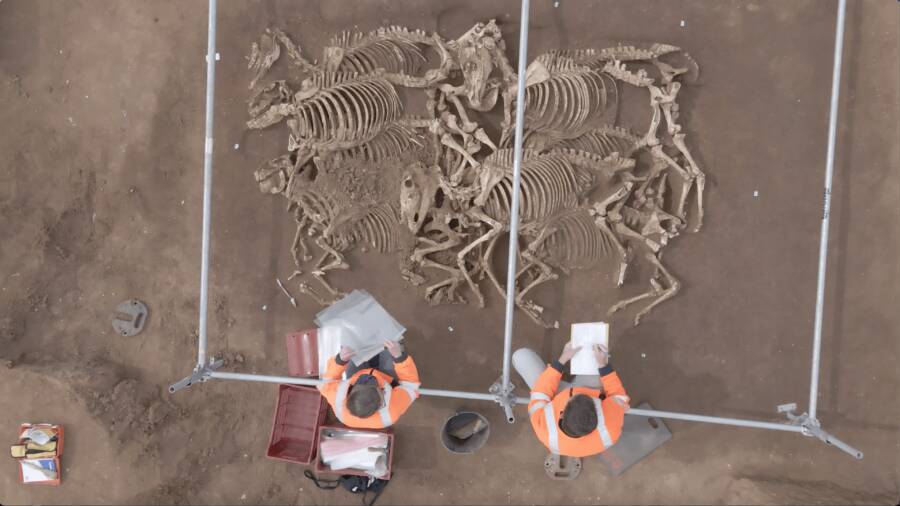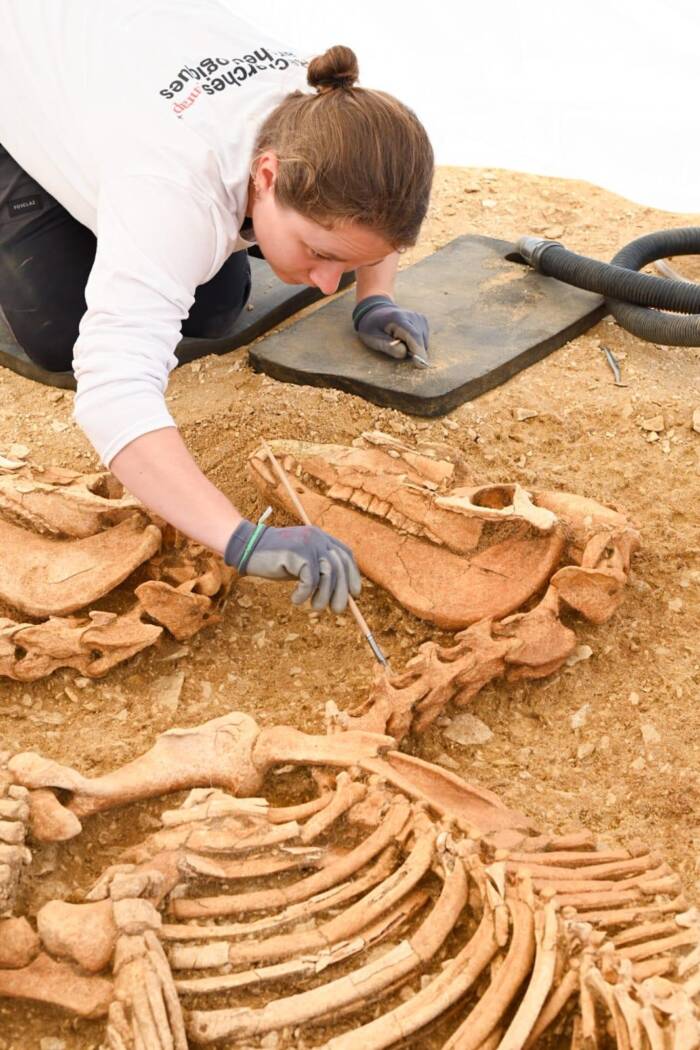Archaeologists aren’t yet sure how the horses died, but it’s possible that they were ritually sacrificed or were killed in battle during the Gallic Wars.
François Goulin / INRAPThe graves control 28 male Equus caballus buried some 2,000 years ago .
While excavating a land site in Villedieu - Tyre - Indre , France , archeologist came across the skeleton of a horse . Then another . And then another . In all , they ’ve identified the stiff of 28 horses so far .
The knight were eat up some 2,000 years ago , around the time of the romish conquest of Gaul . However , many question about this uncovering still stay .

François Goulin/INRAPThe graves contained 28 male horses buried some 2,000 years ago.
Discovering The Horse Burials In France
According to a affirmation from theInstitut internal de recherches archéologiques préventives(National Institute for Preventive Archaeological Research or INRAP ) , the discovery of the knight burials in Villedieu - sur - Indre came as archaeologists excavated a land site from the Middle Ages .
As they uncovered building , infernal region , ditches , and a course from the fifth and sixth hundred , the INRAP archaeologists also falter upon nine much older pits containing the remains of horses . Radiocarbon dating evoke that the horse were buried some 2,000 years ago , between 100 B.C.E. and 100 C.E.
“ We were surprised to find so many pits containing horses , because horses in Gaul were a sign of wealth and prestige , ” INRAP scientific coach Isabelle Pichon toldAll That ’s Interesting . “ Above all , these animals were buried with care . This is not a render pit or the wastefulness from a farm . ”

Hamid Azmoun/INRAPThe horse skeletons were discovered during an excavation of a site from the early Middle Ages.
Hamid Azmoun / INRAPThe buck skeletal system were discovered during an excavation of a internet site from the early Middle Ages .
After notice 10 sawhorse skeletons in the first endocarp , archaeologists amount across two more horse skeletons in a second pit . They ’ve identified a total of 28 sawbuck across all nine pit , but only the first two have been fully excavate .
The horse cavalry they ’ve key out so far all have similar characteristics . They ’re young adult , all over four geezerhood old . They ’re manful . They ’re diminished Gallic horses , about four feet high at their withers . And they were apparently bury with a good deal of tending very soon after they died .

Hamid Azmoun/INRAPArchaeologists aren’t entirely sure why the horses were buried in Villedieu-sur-Indre, but they do have some theories.
So , why were these gymnastic horse buried in such a room at all ?
Sacrifices, War Victims, Or Something Else?
Hamid Azmoun / INRAPArchaeologists are n’t entirely certain why the horse were sink in Villedieu - sur - Indre , but they do have some hypothesis .
fit in to the INRAP instruction , archaeologists are n’t sure why these horses were inter thousands of days ago . “ The effort of death , ” the statement noted , “ accidental or knowing , has not yet been learn . ”
“ I hope that the work of the os and the various analyzes that we will undertake will reply [ the question of how the horses die ] , ” Pichon toldAll That ’s Interesting . “ For the minute , we have not discover any signs of drubbing on the bone of the horse . ”

Hamid Azmoun/INRAPThough archaeologists don’t believe that the horses died from disease, they’ve speculated that they could have been killed in a sacrifice — but their cause of death has not yet been determined.
But experts have some surmisal about what materialize .
For dispatcher , archaeologist do n’t believe that the buck pass during an epidemic because the Steffi Graf only check adult manly cavalry , not mares or foal . However , it is possible the horses were give .
“ The hypothesis of animals sacrificed as part of a complex ritual , of which we only have a few fragments , must also be considered , ” the INRAP financial statement explain . “ The numeral of horses give represent a monumental drainpipe on the nitty-gritty of a herd . This toilsome investment then evidence to the importance of the forfeit . ”
Hamid Azmoun / INRAPThough archaeologists do n’t consider that the horses died from disease , they ’ve meditate that they could have been killed in a forfeit — but their movement of death has not yet been learn .
Another possibility is that the horses died during the battles of the Gallic Wars when mass in Gaul fought to defend their district against Romans led by Julius Caesar . Indeed , similar mass burials of horses elsewhere in France have been tentatively linked to the Gallic Wars .
“ These horse bury in a spectacular showing think the exceptional discoveries of INRAP in Auvergne , at Gondola and l’Enfer , French site in the Gergovie plain stitch , ” the assertion explains . It tally : “ [ T]he aggregated presence of adult male horses dating from the end of French independency , make the contact between the burial of these horses and the battles of the Gallic War attractive . This guess is also potential in Villedieu - sur - Indre . ”
For now , the mass burial of horses in Villedieu - sur - Indre remain a ride historic mystery story . Did the horses perish from disease ? Were they sacrificed in an ancient ritual ? Or did they turn a loss their life story fighting against the Romans ? For now , the resolution is elusive .
After reading about the 2,000 - year - old horse burials discovered in France , reckon through these stunningphotos of the Paris catacombs . Or , discover the write up ofLa Belle Epoquewith this gallery of beautiful image .